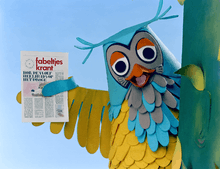Fabeltjeskrant
Fabeltjeskrant [(də) 'faːbəɫcəskrɑnt] (or De Fabeltjeskrant, Dutch for "The Fables Newspaper") is a Dutch children's television series featuring puppetry and stop motion. Created in 1968 by Leen Valkenier and produced by Thijs Chanowski (1st series) and Loek de Levita (2nd series), it ended in 1989 and was broadcast on the Dutch and Japanese channels NOS, RTL 4 RTL 8 and NHK [1] and on Belgian channel VRT. From 1973 to 1975 it was broadcast also in the United Kingdom, on ITV, with the title The Daily Fable.[2]
| Fabeltjeskrant | |
|---|---|
 "Meneer de Uil", the main character of the series | |
| Based on | The work of Leen Valkenier |
| Country of origin | Netherlands |
| No. of episodes | 1640 |
| Production | |
| Producer(s) | Thijs Chanowski Loek de Levita Andrew Davenport (British version) Lykke Li (swedish version) Max Matsuura (japanese version) Charles Gillibert (French version) |
| Running time | 4/5 minutes |
| Release | |
| Original network | NOS (Netherlands) Récré A2 (France) RAI 1 / TMC (Italy) NRK (Norway) SVT (Sweden) ITV (UK) NHK (Japan) |
| Original release | 29 September 1968 – 4 October 1989 |
| External links | |
| Website | |


Plot
Each episode is based upon fables of Jean de La Fontaine, Aesop, Phaedrus and also by the series' scenographer Leen Valkenier. The main character, the owl "Meneer de Uil", introduces each episode reading a fable to other characters upon a tree. The scene is a forest inhabited by different anthropomorphic paper animals and the first episode was broadcast on 29 September 1968 on NOS.
Characters
All character surnames are referred to their species.
- Meneer de Uil (Mr. Owl), or Jacob de Uil,[3][4] is an owl and the main character of the series. In British version his name was "Mr. Owl".[2]
- Other characters: Juffrouw Ooievaar (Miss Stork in the British version), Lowieke de Vos (Mr. Cunningham in the British version), Crox de Raaf (or Meneer de Raaf) (Mr. Crow in the British version), Bor de Wolf (Boris the Wolf in the British version), Ed Bever (Fred Beaver in the British version), Willem Bever (Bert Beaver in the British version), Zoef de Haas (Zippy the Hare in the British version), Stoffel de Schildpad (Shelly the Tortoise in the British version), Momfer de Mol, Truus de Mier (Miss Ant in the British version), Gerrit de Postduif (Gerald the Pigeon in the British version), Meindert het Paard (Milord the Horse in the British version), Myra Hamster, Martha Hamster, Woefdram, Isadora Paradijsvogel, Droes de Beer (Harold the Bear in the British version), Jodocus de Marmot (George the Guinea Pig in the British version), Chico Lama, Zaza Zebra, John Maraboe, Greta Bontekoe, Teun Stier, Oléta Vulpécula, Harry Lepelaar, Piet de Pad, Tijl Schavuit, Sjefke Schelm, Rocus de Vrije Vogel, Pepijn de Kater, Timme de Hond, Plons de Kikvors, Blinkert de Bliek, Arthur de Leeuw, Flora Nachtegaal, George de Wezel, Stokebrand de Mug, Mia de Muilezel, Maup de Muis, Marius de Bok, Irma de Krekel, Orm de Aap, Toeter de Olifant, Kirreke de Tortelduif, Koer de Tortelduif, Frija Forel, Greta 2, Hondje Woef, Wasa de Beer, Melis Das, Lamaar Snoespoes, Woef Hektor, Wip de Eekhoorn, Gies de Vlieg, Arie de Rat, Borita, Cas de Kraai and Asa de Spin.[5]
In other countries
The show was adapted in some other countries under the following titles:
- France: Le petit écho de la Forêt[6] (French for The Little Echo of the Forest)
- Hungary: Fabulácskahírek[7] (Hungarian for The Fables Newspaper)
- Israel: Sipurimpo (Hebrew for Stories Here)
- Italy: Il bosco dei perché[8][9] (Italian for The Wood of the Questions)
- Norway: Fablenes bok (Norwegian for The book of Fables)
- Sweden: Fablernas värld[10] (Swedish for World of Fables)
- United Kingdom: The Daily Fable[2]
- Peru: Las Crónicas de Fabulandia (Spanish for Chronicles of Fableland)
- Mexico: Las Crónicas de Fabulandia (Spanish for Chronicles of Fableland)
- Japan: “Fachishu shinbun (Japanese for “The animals of Fables village”)
Adaptations
Lex Overeijnder wrote and drew a short-lived newspaper comic strip based on the TV show in 1969.[11] In 1975 Dick Vlottes created another comic strip based on the series, which was published in the TV magazine Televizier in 1975.[12]
In 1970, a film version, Onkruidzaaiers in Fabeltjesland, premiered in theaters.
In 2007 a musical adaptation was created by Ruud de Graaf and Hans Cornelissen.
Comeback
In November 2017, a new 3D animated series was announced. It was broadcast in 2019 on Netflix in the Netherlands.[13]
In 2018 a book, an exhibition and a movie were launched to celebrate the 50th anniversary.
See also
- Sesamstraat (another Dutch children's television series featuring puppetry)
Notes and references
- "Welkom op Fabeltjesweb, HET naslagwerk over de Fabeltjeskrant!". www.fabeltjesweb.nl. Retrieved 7 August 2020.
- Cream, T. V. "Daily Fable, The – TV Cream". Retrieved 7 August 2020.
- "Meneer de Uil". www.fabeltjesweb.nl. Retrieved 7 August 2020.
- See also nl:Meneer de Uil
- "personages". www.fabeltjesweb.nl. Retrieved 7 August 2020.
- "Le petit echo de la foret". casimiragoldorak.free.fr. Retrieved 7 August 2020.
- See also: hu:Fabulácskahírek
- "AntonioGenna.net presenta: IL MONDO DEI DOPPIATORI - ZONA ANIMAZIONE: "Il bosco dei perchè"". www.antoniogenna.net. Retrieved 7 August 2020.
- See also: it:Il bosco dei perché
- See also: sv:Fablernas värld
- "Lex Overeijnder". www.lambiek.net. Retrieved 7 August 2020.
- "Dick Vlottes". lambiek.net. Retrieved 7 August 2020.
- "Privacy settings". myprivacy.dpgmedia.net. Retrieved 7 August 2020.
External links

- (in Dutch) Official website
- Fabeltjeskrant on IMDb